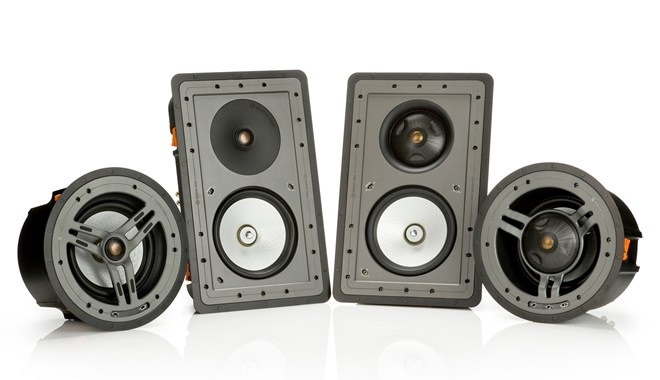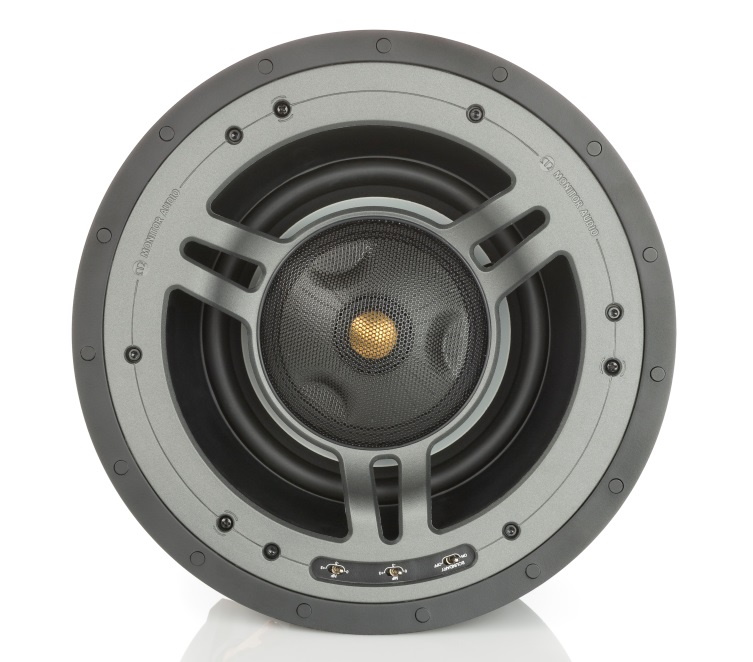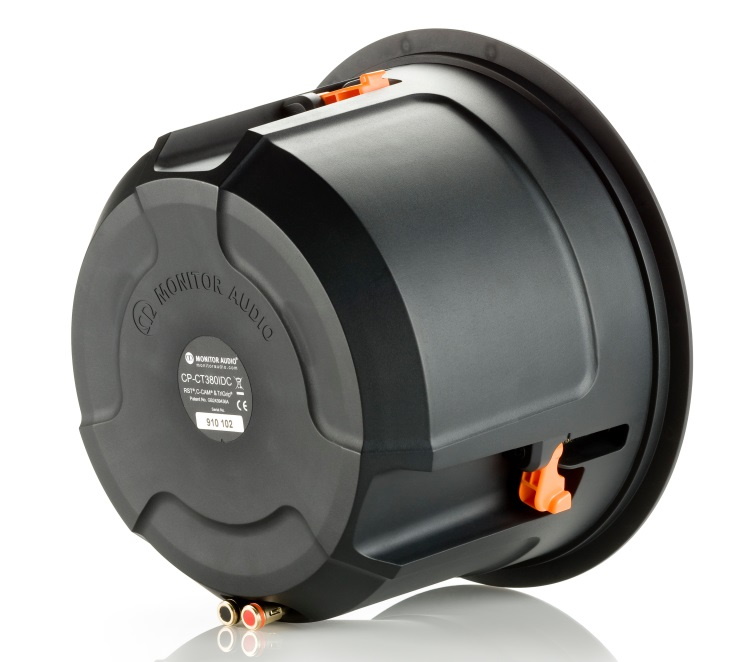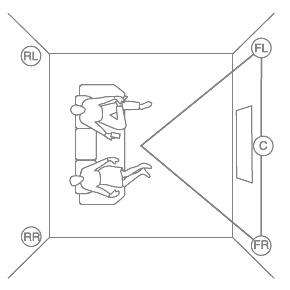Ci Speaker Installation
In-ceiling and in-wall speakers have become a more popular choice among home owners looking for ways to reduce speaker clutter. Irrespective of whether it is a room decor issue or floor space problem, in-wall and in-ceiling speakers represent the ideal choice if you want to hide away your sound source while still enjoying great music or home theatre sound.
During these last years, in-wall and in-ceiling speakers sound performance has improved to the point that these provide a good match to that of free-standing speakers. We still say that if you want the very best in home theater sound and multi-channel music listening, use of free-standing speakers is your only option. But there is no doubt that today's in-ceiling and in-wall speakers sound good enough even for the most demanding enthusiasts.
In this guide, we will cover the basics of in-wall and in-ceiling speakers; then discuss the things to consider when making a purchase for home theater or multi-room audio applications.
In-Wall and In-Ceiling Speaker Basics
In-ceiling and In-wall speakers work like conventional speakers except that they do not come with a cabinet. Instead, they are mounted on a specially designed frame to allow the speaker to be canceling in the wall or ceiling. In this way, in-wall and in-ceiling speakers use the wall or ceiling cavity as a large cabinet. This explains why they tend to deliver more bass especially when not mounted in a suitably designed back-box. However, if you are after the best sonic performance with in-wall speakers, it is not recommended to leave the back box out of your equation when planning an in-wall or an in-ceiling speaker installation.
The problem with in-wall speakers is that you will never know how your concealed speakers will sound until you install them. It is true that some ceiling and in-wall speaker systems come with dedicated bass and treble tone controls to help you better tune your speakers once installed with the rest of your speaker setup.
The presence of a back box designed specifically for your selected in-wall or in-ceiling speaker will do a lot more to control your in-wall speaker or ceiling speaker performance. The back box gives you better control over resonance, while maintaining the correct tonal balance with the rest of your home theater speakers; the latter is fundamental to achieve a unified soundfield in multichannel audio.
In general, most in-wall speakers come in a rectangular frame while in-ceiling speakers are round. Choosing one shape over another is more an issue of personal preference. All in-wall and in-ceiling speakers come with accompanying speaker grills - most of which are paintable to better conceal the speaker from view.
The use of in-wall and in-ceiling speakers is definitely turning out to be a trendy option in the home theater but there are a few issues worth knowing about...
Both speaker options require at least 4-inch clearance behind the mounting panel to house the speaker unit. Some require even more mounting clearance especially if the speaker driver is either tilted in some direction, or uses an adjustable pivot to enable the user direct more of the speaker sound to the audience.
In the case of in-wall speaker units, it is possible to find slim-type units that may require just over 2-inch clearance but be aware that the acoustic quality may suffer. Keep in mind that the volume of a speaker enclosure plays a critical role in speaker performance; without enough physical depth, a speaker produces less fuller sound.
In-Ceiling and In-Wall Speakers for your Home Theater
What you need to know
One issue many come across when design a home theater is surely that of speaker placement, or rather how the many different audio speakers associated with today's 5.1 and 7.1-plus multi-channel audio systems are going to impact the overall home theater room decor.
Well, it is here that in-wall and in-ceiling speakers provide suitable alternatives to free-standing conventional speakers in both the home theater and in multi-room home entertainment.
Up to not long ago, this hidden-sound technology did not perform well especially in multi-channel 5.1 music listening and home theater applications. Stereo sound has always been much easier to satisfy with in-wall and in-ceiling speaker systems.
But things have changed...
Today, you can conceal specially designed speakers in walls and in ceilings while still enjoying really good quality sound — though not to the same extent as is possible with conventional free-standing speak systems for the same capital outlay.
Equally important is that high-quality in-wall speakers can be especially expensive in comparison to traditional home theater speakers. A case in point is the Monitor Audio CP-CT380-IDC Dedicated Cinemas Ceiling Speaker and C380-FX Rear effects Ceiling Speakers.
 |
 |
In-ceiling home theater speakers suffer from a major acoustical disadvantage over both in-wall and conventional free-standing speakers, namely that of firing directly at the floor. This acoustical disadvantage would be further enhanced by a bare floor. Some in-ceiling speakers such as the CP-CT380-IDC shown here use a tilted speaker to direct more of their sound towards the listener.
This floor-firing characteristic limits the use of in-ceiling speakers to general audio applications in offices and whole-house installations rather than in multichannel speaker setups in the home theater. Their use in the home theater is rather limited as rear surrounds rather than as front speakers.
Ceiling and In-Wall Audio Speaker Placement:
Directly related to the issue of speaker installation is your in-wall or in-ceiling speaker placement. Again, the same principles highlighted in our Speaker Placement guide applies; however you have to translate the requirements associated with free-standing speakers to your concealed speaker installation.
There is one major problem here one should be aware of when dealing with ceiling and in-wall speakers — especially in the home theater where speaker placement is critical for an immersive listening experience.
With this type of speaker installation, there is no room for speaker placement experimentation; it just has to be right the first time. Surely, you do not want to end up with a big hole in the wall or ceiling simply because you got your speaker placement wrong! The little added-flexibility provided by pivoted in-wall and in-ceiling speaker systems is definitely not enough to correct for a wrong speaker replacement.
Our advice: When dealing with the placement of in-wall and in-ceiling home theater speakers, it is always recommended to seek on-site professional advice.
Use of subwoofers with In-Ceiling and In-Wall Speaker Installations:
The best way to complement the sound of ceiling and in-wall speakers is to use a dedicated subwoofer. Rather, while with full-size free-standing tower speakers, you may do away with a dedicated subwoofer, this is not the case with in-wall and in-ceiling speaker installations. In these circumstances, the use of a dedicated subwoofer helps produce a fuller, more realistic sound although this is really only required when it comes to home cinema.
In-wall subwoofers are readily available although some of these are passive (not powered) the Monitor Audio IWB-10, IWS-10 and IWA-250 driver, backbox and amp combination is a great option for full active power in an in-wall configuration.
However, a free-standing option should not be an issue when it comes to subwoofers. Most powered subwoofers are small enough to be placed behind your couch. One main advantage of subwoofers with respect to the rest of your home theater speakers is that subwoofer placement is not critical. In other words, you can almost literally hide your subwoofer away from site without affecting sound performance.
Getting the best performance from your ceiling speakers and In-wall speakers
The following information is a short guide to Installing ceiling and In-wall speakers. Reading through the information before attempting speaker installation will ensure you get the best performance from your in-wall and ceiling speakers
Precaution
Turn off all system power before connecting speakers.
Always wear protective eye wear when using tools.
Wear gloves when working with fiberglass loft insulation.
Necessary Installation Tools
- Drill
- Drill Bit ¼’ ~ ½’
- Stiff Wire (coat hanger or fish tape)
- 1’ Flat Bit (use if drilling through studs)
- Gloves
- Phillips Screwdriver
- Wire Strippers
- Plasterboard Saw
- Pencil
Step 1 – Choose Speaker Placement:
All applications apply for Ceiling and In-Wall speaker installation. The In-Wall and Ceiling speakers may be used in new or existing ceiling or wall installations to reproduce stereo music or home cinema surround sound. In this section, we’ll discuss a number of tips and techniques to help you plan the installation and achieve the best sound performance from your speakers.
Placing Speakers for Stereo Sound
In-Ceiling and In-Wall speakers have a uniform (hemispherical) dispersion and do not require special orientation for good sound. For stereo music listening, place the speakers in the ceiling or wall, to the left and right.
Think of your listening area as one tip of a triangle with each leg of the triangle being equal. See speakers FL (front left) and FR (front right) in Figure 1 below. Place the speakers as close as possible to the two points they represent on the triangle.
Figure 1.

Placing Speakers for Surround Sound
For surround sound the minimum amount of speakers used will be five. Three at the front, FL (front left channel) FR (front right channel) and C (centre channel) and two at the back, RL (rear left) and RR (rear right). The front three speakers need to be on a level plane as possible with your ears whilst in your seating position. This can either be achieved using in-wall speakers or the purpose built surround sound ceiling speakers which have angled drive units that point directly down to your listening position. The two rear speakers need to be placed left and right and directly behind your seating position, see Figure 1 above.
Designing For Even Sound Distribution
When designing ceiling speaker systems in a multi-room environment, an important goal is uniform sound coverage throughout the home. The goal should be to distribute the sound evenly in a way that will not interfere with conversation and general day to day activities. In rooms where listening to music isn't a primary objective (i.e back ground music) it is best to place the speakers around the perimeter of room. It is especially important not to mount speakers above dinning tables or seating areas so that people are not sitting directly under a speaker.
In locations where the primary objective is to listen to music the speakers can be placed evenly left and right of the rooms main seating position as mentioned above.
If you need further help with the placement of your ceiling speakers please call or email us.
Step 2 - Check For Obstructions:
If an obstruction is found behind the plasterboard in the proposed location, you will need to choose a different location for the speaker. Before installing In-Wall or Ceiling speakers in pre-existing plasterboard, check for joists or any other obstructions, such as metal pipes, which are hidden from your view.
Stud Locator:
The easiest, most efficient way to detect obstructions behind plasterboard is to use a stud finder. At each proposed speaker location, use the stud locator to find an open space. Try to centre each speaker between the joists. Slide the stud locator horizontally and vertically across the ceiling or walls to locate the joists or any other obstructions.
Step 3 – Cut Speaker Openings:
- At each speaker location, use the cardboard template to trace a cut line onto the ceiling or wall.
- At each location, drill a small hole in the plasterboard at the centre of the outline.
- Bend a piece of stiff wire (e.g. coat hanger) about 6 inches from the end at a 90 – degree angel. Insert the bent end into the hole and rotate the wire to check for any obstructions. If you hit anything, patch the hole with plasterboard filler and choose a different installation location.
- Using a fine – Plasterboard saw, carefully cut out each opening.
- When finished cutting, remove plasterboard scrap from hole.
Step 4 – Connecting Speakers:
- Strip the speaker wire with a pair of wire strippers.
- Carefully strip off 50mm of the outer jacket. This will reveal the conductor contained inside – two conductors for 2 conductor wire; four conductors for 4 conductor wires.
- Conductors are protected by a plastic, colour-coded insulation jacket that must also be stripped. Carefully strip 15mm of insulation off the conductors that you need. This will expose the copper wire contained within. You are now ready to connect the wire to your speaker.
- When connecting wires, observe the proper polarity of your amplifier (+) to (+) Red conductor (-) to (-) Black conductor also make sure that the left channel of the amplifier is connected to the left speaker, and the right channel is connected to the right speaker. For surround Sound, connect the speaker to the appropriate channel on the amplifier or receiver.
- Now connect the (-) and (+) conductors cables to the corresponding (-) and (+) speaker terminals. Gently pull on the wire to verify a secure connection.
Step 5 – Installing the Speakers:
- The easy and fast clamp installation procedure found on all the speakers that we supply, allows you to simply clamp your speaker in place. Remove the grill by gently pushing one of clamp legs toward the front of the speaker. They should lie in the full clockwise position so that all clamps lay within the speaker cutout.
- Insert the speaker into the cut hole bringing the outer edge flush with the ceiling/wall. Use a Philips screwdriver to tighten the four screw heads located around the front edge of the speaker. This will automatically rotate the clamps behind the plasterboard and securely grip your speaker flange to the ceiling/wall.
- When you notice resistance in the tightening of all four screws the speaker has been successfully sandwiched between the plasterboard and the speaker flange. The clamps provide a tight fit and prevent unwanted vibration.
- The screws should not be tightened so far that the flange bows, this will make the grill hard to fit. If this occurs, back off the tension on the screws a little.
- Gently push the speaker grill into the speaker baffle.
Step 6 - Final Adjustments:
Most of todays ceiling speakers have an adjustable tweeter arrangement, which directs sound toward or away from the listening area to achieve a desired effect. Press on the outside plate to aim the tweeter so it fires at a desired listening area.
NOTE: Do not press the tweeter itself. Doing so may damage it and cause a distortion or poor performance.
Here are some additional suggestions:
- Orient the tweeter toward the listing area if the speakers are widely separated and the music fails to blend into a central image when the system is operated in stereo.
- Orient the tweeter toward the listening area when additional brightness is desired.
- Orient the tweeter away from the listening area if the music or video sound stage seems too narrow or restricted.
- Orient the tweeter away from listening area if it sounds too bright.
- For home cinema surround applications, orient the rear speaker tweeters away from the listening area so that the sound reflects off an adjacent wall or ceiling. This will help create the desired diffuse sound field.
Painting The Speakers - Optional
If you plan to paint your speakers, we recommend that it be done prior to installation.
If you decide to paint your speakers sometime in the future, it is best to remove them by simply reversing the steps for speaker installation listed above. When painting the speakers, the paint masks provided in the box must be installed in place of the grille.
The speaker grilles can also be painted. However, great care should be taken not to clog the holes, as this will greatly reduce the sound quality of the speakers. Before painting the grilles, remove the material from under the grille. Place this material back in place once the grille has been painted.
The Custom Speaker Company recommends only light spray painting using 5 parts thinning agent to 1 part paint. Do not paint the grilles while they are attached to the speaker.
